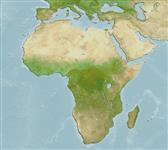Classification / Names
Common names | Synonyms | Catalog of Fishes (gen., sp.) | ITIS | CoL | WoRMS | Cloffa
Actinopterygii (ray-finned fishes) >
Siluriformes (Catfish) >
Mochokidae (Squeakers or upside-down catfishes)
Etymology: Synodontis: Greek, syn, symphysis = grown together + Greek, odous = teeth (Ref. 45335); lucipinnis: The specific name is a combination of the Latin luci, meaning bright or clear, and the Latin pinnis, meaning fin, a reference to the light patches found at the base of the black triangles found on the rayed fins of this species (Ref. 59365).
Environment / Climate / Range
Ecology
Freshwater; demersal. Tropical, preferred ?
Africa: endemic to Lake Tanganyika, only known from the type locality in Zambia (Ref. 59365).
Size / Weight / Age
Maturity: Lm ? range ? - ? cm
Max length : 7.9 cm SL male/unsexed; (Ref. 59365)
Short description
Morphology | Morphometrics
Dorsal
spines
(total): 2;
Dorsal
soft rays
(total): 7-8;
Anal
spines: 0;
Anal
soft rays: 12 - 13;
Vertebrae: 34 - 35. Body is not compressed; predorsal profile is slightly convex; skin on body forming numerous vertical folds; papillae absent; head slightly depressed and broad (Ref. 59365). Eyes dorsolateral, ovoid, its diameter 25.2-35.8% of snout length (Ref. 59365). Mandibular teeth 35-51, short and unicuspid, arranged in 6 short, transverse rows (Ref. 59365). Maxillary barbel short, extending at least to base of pectoral spine, with small papillae at base and narrow basal membrane; lateral mandibular barbel extending to point just past anterior margin of pectoral girdle, with 4-6 short, simple, weakly tuberculate branches, usually lacking secondary branches; medial mandibular barbel approximately 1/3 to 1/2 length of lateral barbel, with 4-6 pairs of tuberculate branches, many secondary branches present (Ref. 59365). Dorsal fin spine short, striated, slightly curved, terminating in a short, white filament; anterior margin of spine smooth, posterior margin with small serrations distally (Ref. 59365). Pectoral fin spine roughly equal in length to dorsal fin spine, striated, slightly curved, terminating in short, white filament; anterior spine margin smooth, posterior margin with large, retrorse serrations along entire length (Ref. 59365). Adipose fin long, well dveloped, margin convex (Ref. 59365). Body with large spots, fin spines white (Ref. 59365).
This species can be found in rocky, coastal areas; no information on maximum depth, diet or reproduction (Ref. 59365).
Life cycle and mating behavior
Maturity | Reproduction | Spawning | Eggs | Fecundity | Larvae
Wright, J.J. and L.M. Page, 2006. Taxonomic revision of Lake Tanganyikan Synodontis (Siluriformes: Mochokidae). Bull. Florida Mus. Nat Hist. 46(4):99-154. (Ref. 59365)
IUCN Red List Status (Ref. 115185)
CITES (Ref. 94142)
Not Evaluated
Threat to humans
Harmless
Human uses
Fisheries:
More information
Common namesSynonymsMetabolismPredatorsEcotoxicologyReproductionMaturitySpawningFecundityEggsEgg development
Age/SizeGrowthLength-weightLength-lengthLength-frequenciesMorphometricsMorphologyLarvaeLarval dynamicsRecruitmentAbundance
ReferencesAquacultureAquaculture profileStrainsGeneticsAllele frequenciesHeritabilityDiseasesProcessingMass conversion
Tools
Special reports
Download XML
Internet sources
